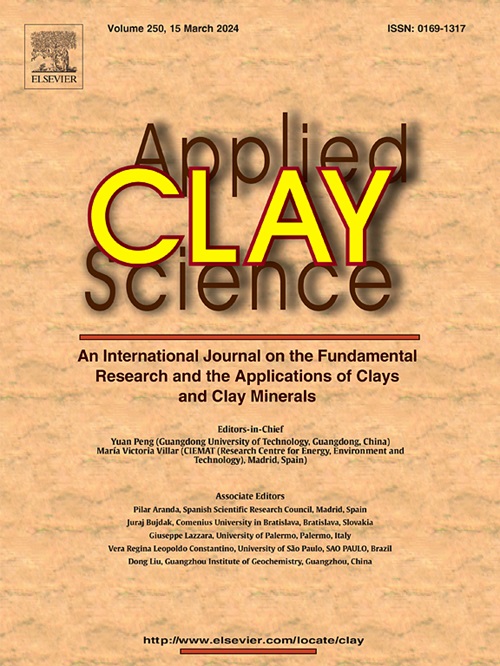Heavy metal ion adsorption mechanism of polysulfide-modified layered double hydroxide
IF 5.3
2区 地球科学
Q2 CHEMISTRY, PHYSICAL
引用次数: 0
Abstract
A detailed study was conducted on the capture mechanism of heavy metals, especially cadmium (Cd), by polysulfide ion ([Sx]2−; x = 3, 4)-intercalated 3D rose-shaped layered double hydroxide (Sx-roseLDH). The roseLDH (Mg/Al = 2) was synthesized by homogeneous precipitation method using hexamethylene-tetramine (HMT) as an ammonia generator. Polysulfides were intercalated between the LDH layers by exchange with Cl− ions. Polysulfide ions were introduced between the LDH layers by exchanging with Cl− ions. The results showed that Sx-roseLDH effectively captured and immobilized Cd2+ ions from aqueous solutions. Additionally, this adsorbent demonstrated strong selectivity for Cd2+ and Zn2+ in simulated wastewater and mixed solutions containing Cd2+, Zn2+, and Ni2+. Such selectivity and high removal efficiency for Cd2+ were not observed with montmorillonite. The adsorption mechanism was investigated through solution analysis after adsorption and solid sample analysis using techniques such as FTIR, Raman spectroscopy, XRD, XPS, SEM-EDS, STEM-EDS, and HRTEM. These analyses revealed that during adsorption, Cd2+ formed CdS through S![]() S bonds and was trapped in the cleavages of the LDH crystals, rather than between the layers. Hg2+ adsorption also resulted in the formation of HgS. This adsorbent efficiently immobilizes heavy metals as metal sulfide nanoparticles, with high selectivity for ions such as Cd and Hg. Furthermore, it was demonstrated that the particle shape of roseLDH is also beneficial for column applications. This suggests that Sx-roseLDH could be an effective adsorbent for industrial wastewater treatment, with the added benefit of reducing sludge generation.
S bonds and was trapped in the cleavages of the LDH crystals, rather than between the layers. Hg2+ adsorption also resulted in the formation of HgS. This adsorbent efficiently immobilizes heavy metals as metal sulfide nanoparticles, with high selectivity for ions such as Cd and Hg. Furthermore, it was demonstrated that the particle shape of roseLDH is also beneficial for column applications. This suggests that Sx-roseLDH could be an effective adsorbent for industrial wastewater treatment, with the added benefit of reducing sludge generation.
多硫化物改性层状双氢氧化物对重金属离子的吸附机理
对多硫离子([Sx]2−;x = 3,4)插层三维玫瑰状层状双氢氧化物(Sx-roseLDH)。以六亚甲基四胺(HMT)为氨源,采用均匀沉淀法合成roseLDH (Mg/Al = 2)。多硫化物通过与Cl−离子交换嵌入LDH层之间。通过与Cl−离子的交换,在LDH层之间引入了多硫离子。结果表明,Sx-roseLDH能有效捕获和固定水溶液中的Cd2+离子。此外,该吸附剂在模拟废水和含有Cd2+、Zn2+和Ni2+的混合溶液中对Cd2+和Zn2+有很强的选择性。蒙脱土对Cd2+的选择性和去除率均不高。采用FTIR、拉曼光谱、XRD、XPS、SEM-EDS、STEM-EDS、HRTEM等技术对吸附后的溶液分析和固体样品分析进行了吸附机理研究。这些分析表明,在吸附过程中,Cd2+通过SS键形成cd,并被捕获在LDH晶体的解理中,而不是在层之间。Hg2+的吸附也导致了HgS的形成。该吸附剂有效地将重金属固定为金属硫化物纳米颗粒,对Cd和Hg等离子具有高选择性。此外,研究表明,roseLDH的颗粒形状也有利于色谱柱的应用。这表明Sx-roseLDH可能是一种有效的工业废水处理吸附剂,具有减少污泥产生的额外好处。
本文章由计算机程序翻译,如有差异,请以英文原文为准。
求助全文
约1分钟内获得全文
求助全文
来源期刊

Applied Clay Science
地学-矿物学
CiteScore
10.30
自引率
10.70%
发文量
289
审稿时长
39 days
期刊介绍:
Applied Clay Science aims to be an international journal attracting high quality scientific papers on clays and clay minerals, including research papers, reviews, and technical notes. The journal covers typical subjects of Fundamental and Applied Clay Science such as:
• Synthesis and purification
• Structural, crystallographic and mineralogical properties of clays and clay minerals
• Thermal properties of clays and clay minerals
• Physico-chemical properties including i) surface and interface properties; ii) thermodynamic properties; iii) mechanical properties
• Interaction with water, with polar and apolar molecules
• Colloidal properties and rheology
• Adsorption, Intercalation, Ionic exchange
• Genesis and deposits of clay minerals
• Geology and geochemistry of clays
• Modification of clays and clay minerals properties by thermal and physical treatments
• Modification by chemical treatments with organic and inorganic molecules(organoclays, pillared clays)
• Modification by biological microorganisms. etc...
 求助内容:
求助内容: 应助结果提醒方式:
应助结果提醒方式:


